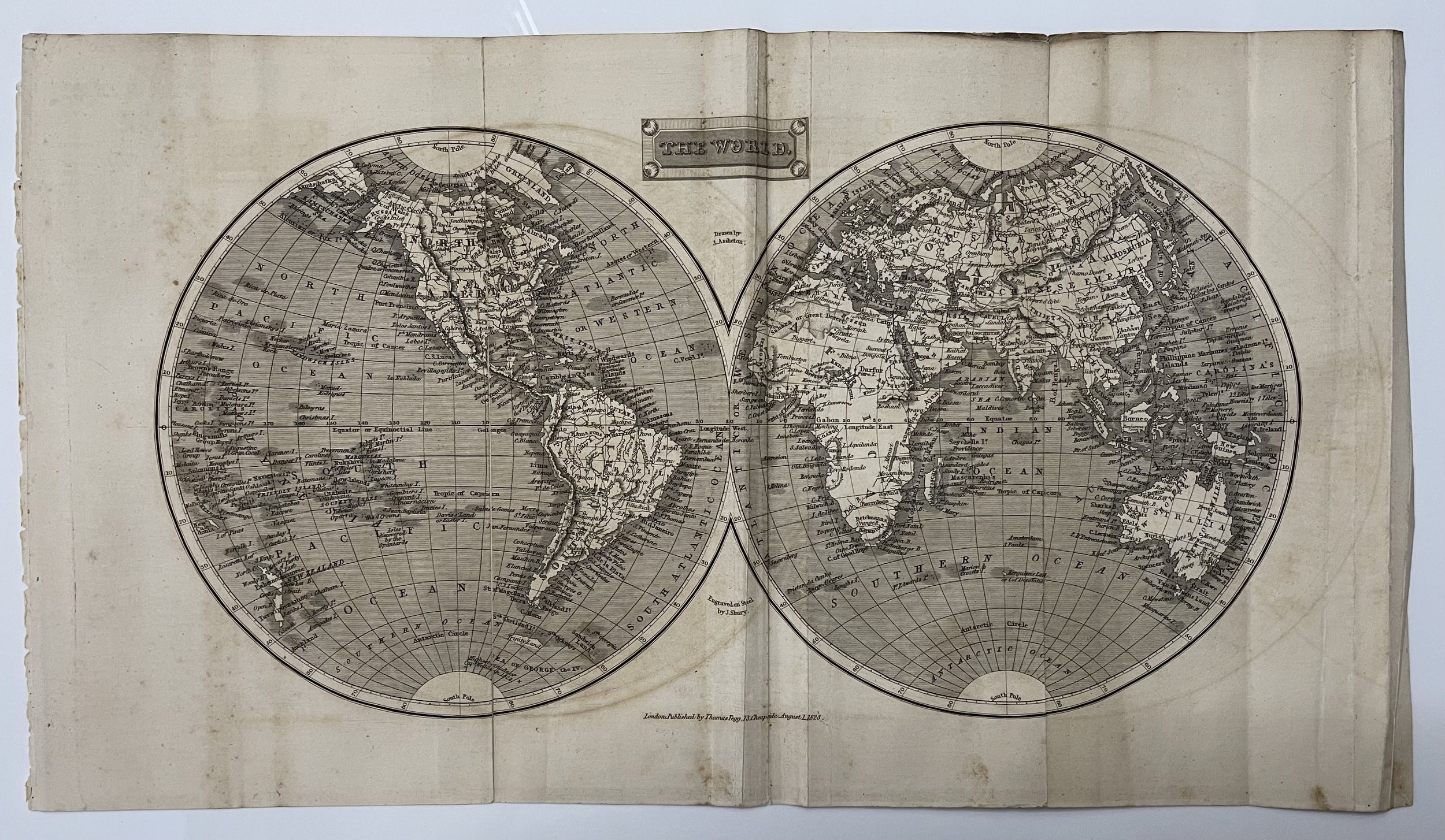 Image 1 of 16
Image 1 of 16

 Image 2 of 16
Image 2 of 16

 Image 3 of 16
Image 3 of 16

 Image 4 of 16
Image 4 of 16

 Image 5 of 16
Image 5 of 16

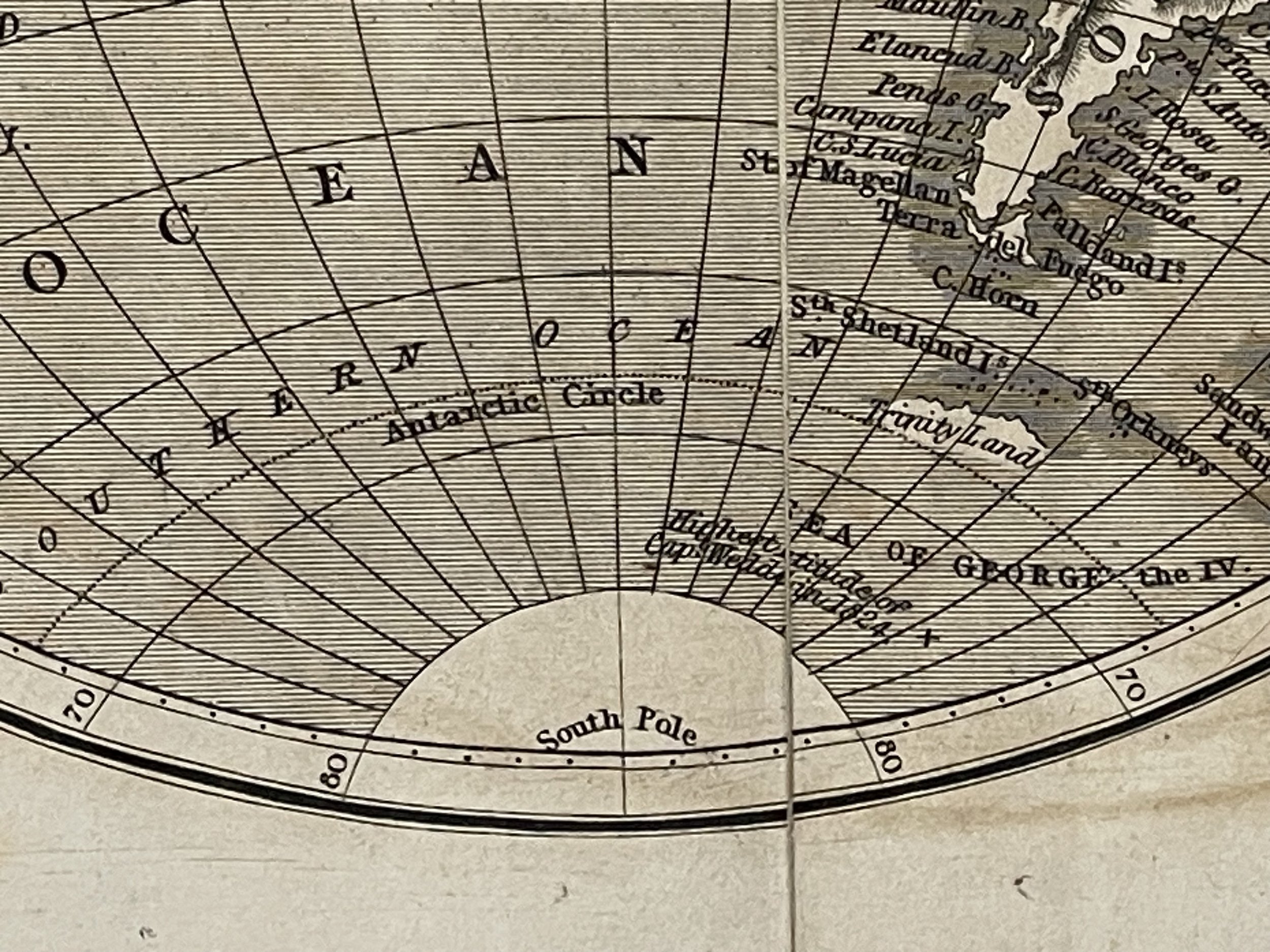 Image 6 of 16
Image 6 of 16

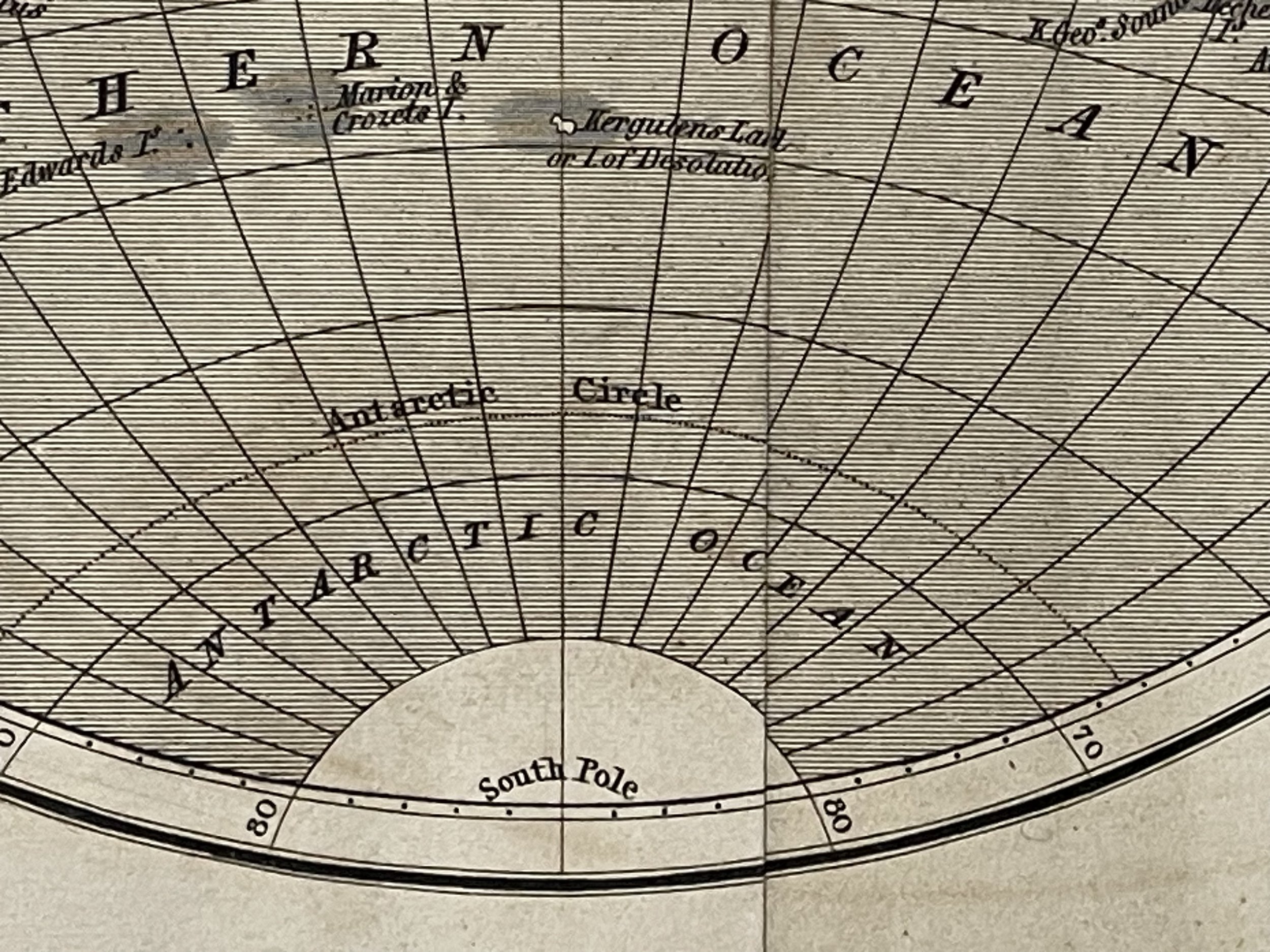 Image 7 of 16
Image 7 of 16

 Image 8 of 16
Image 8 of 16

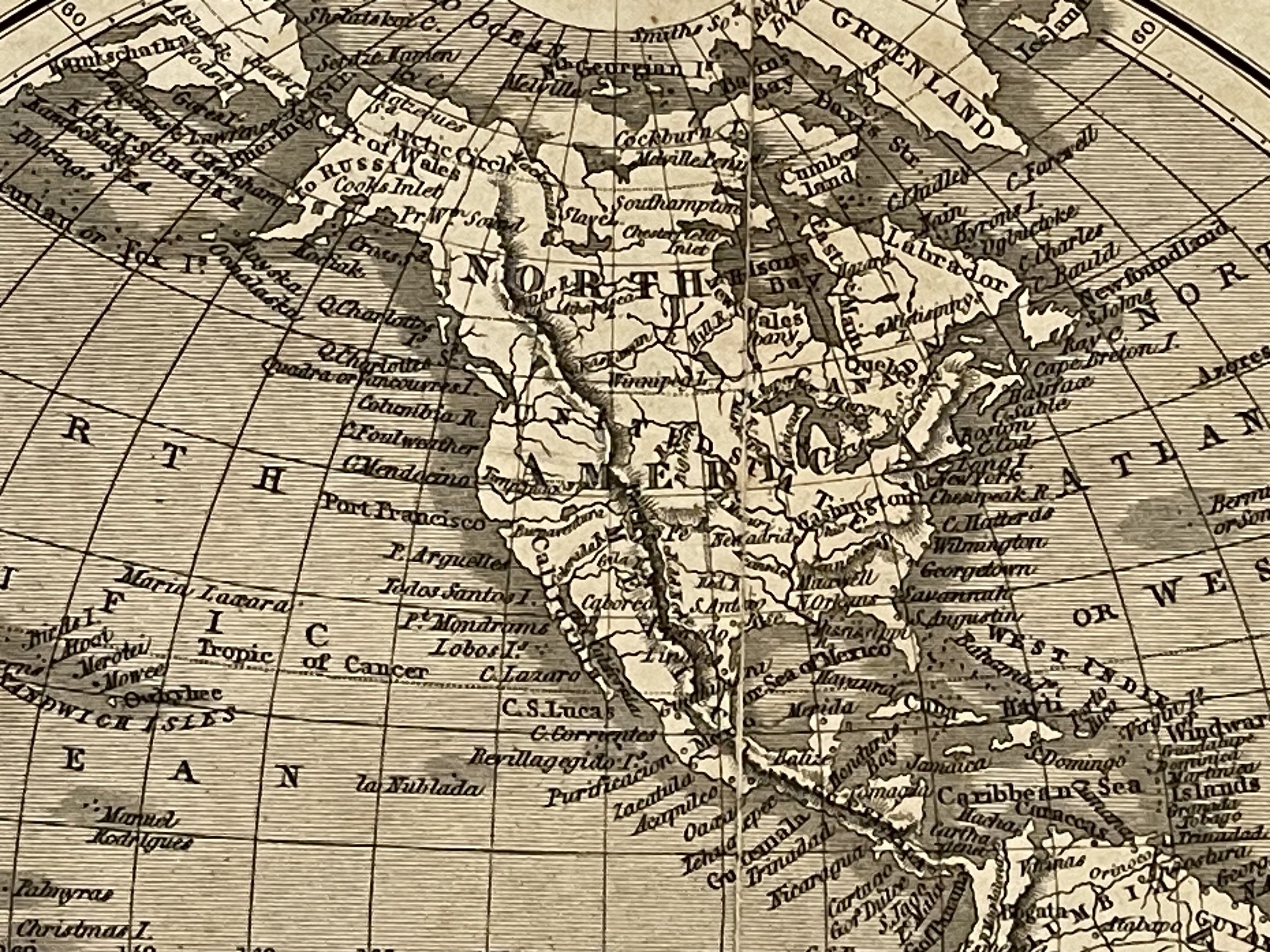 Image 9 of 16
Image 9 of 16

 Image 10 of 16
Image 10 of 16

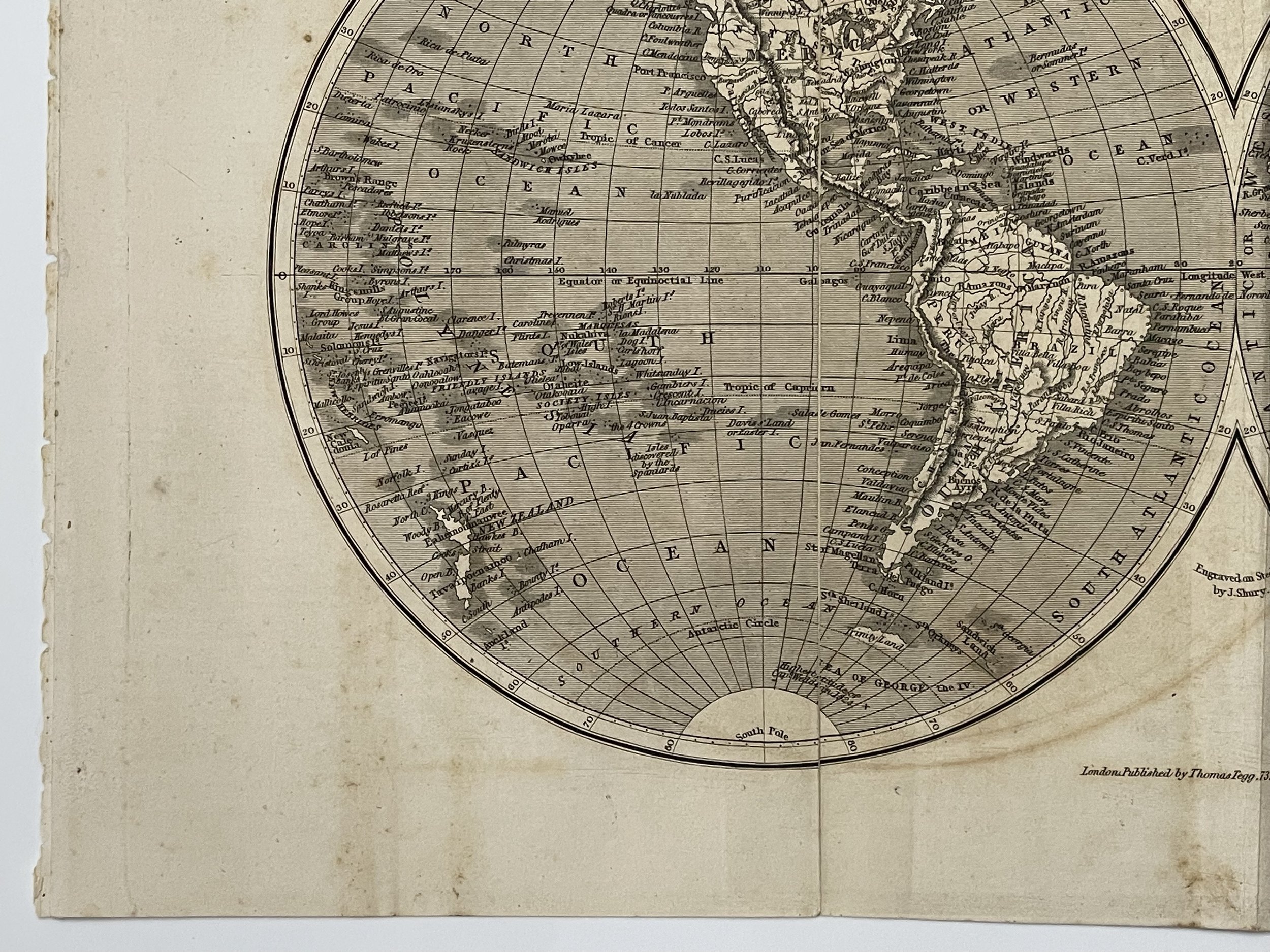 Image 11 of 16
Image 11 of 16

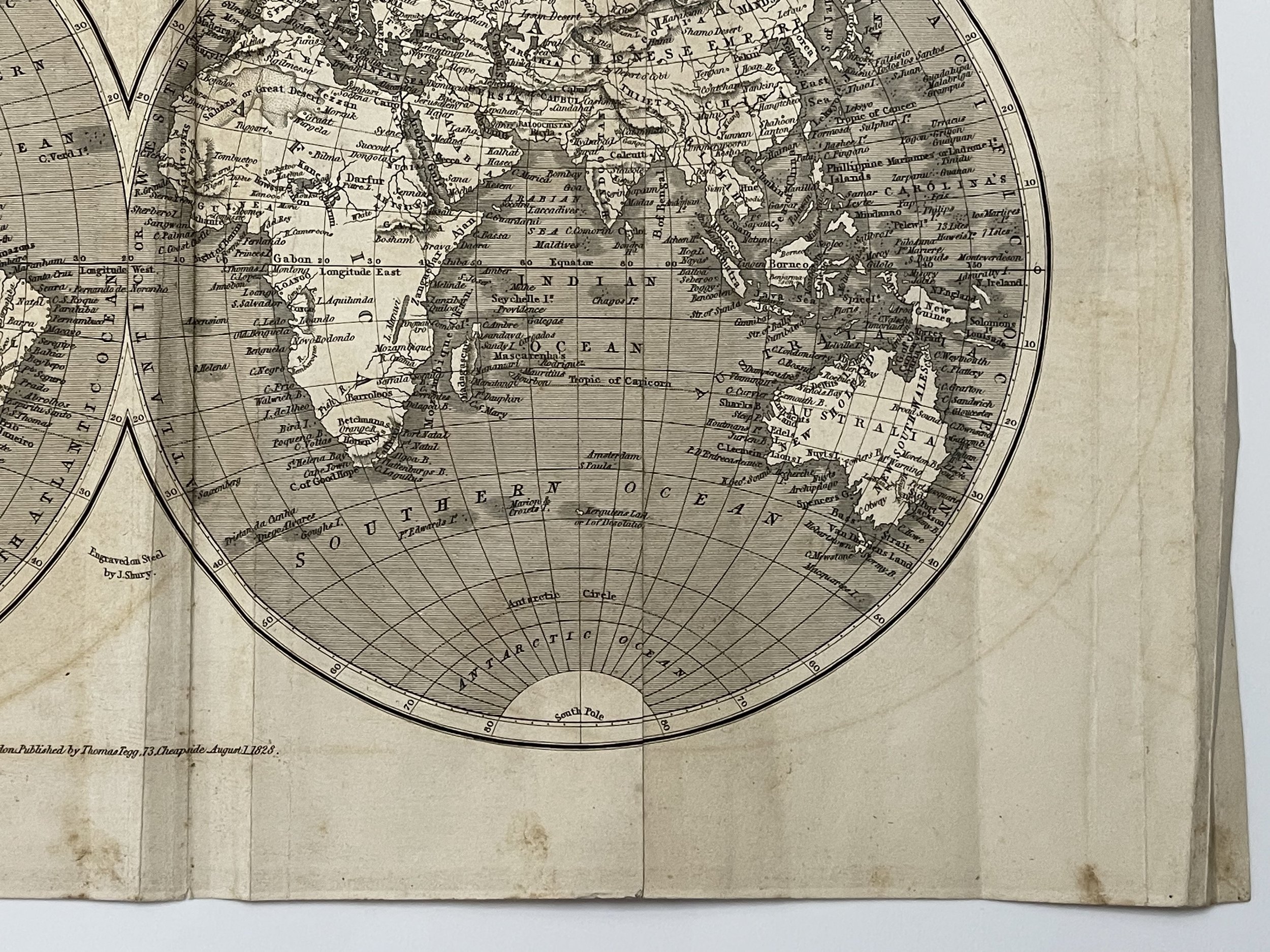 Image 12 of 16
Image 12 of 16

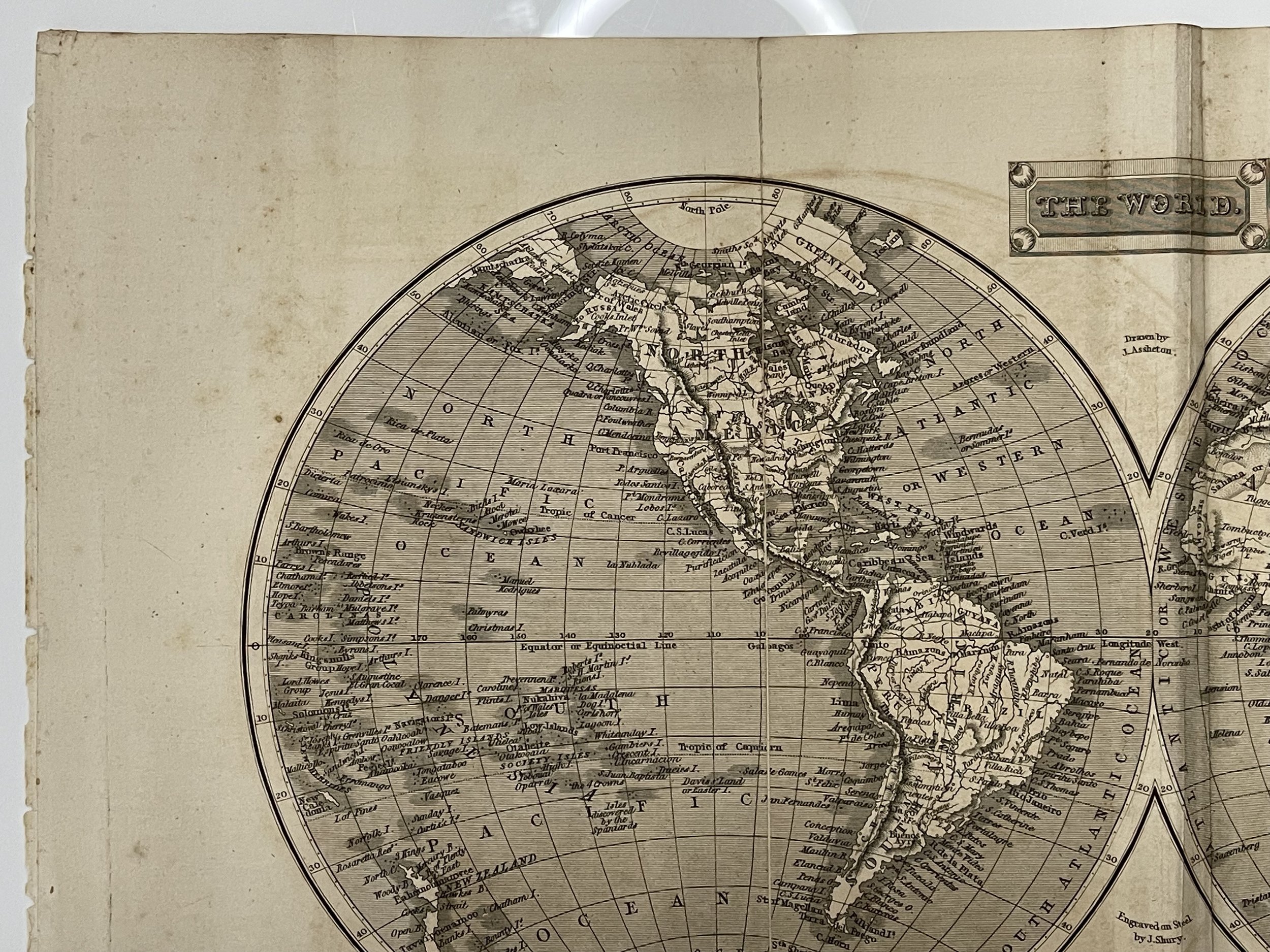 Image 13 of 16
Image 13 of 16

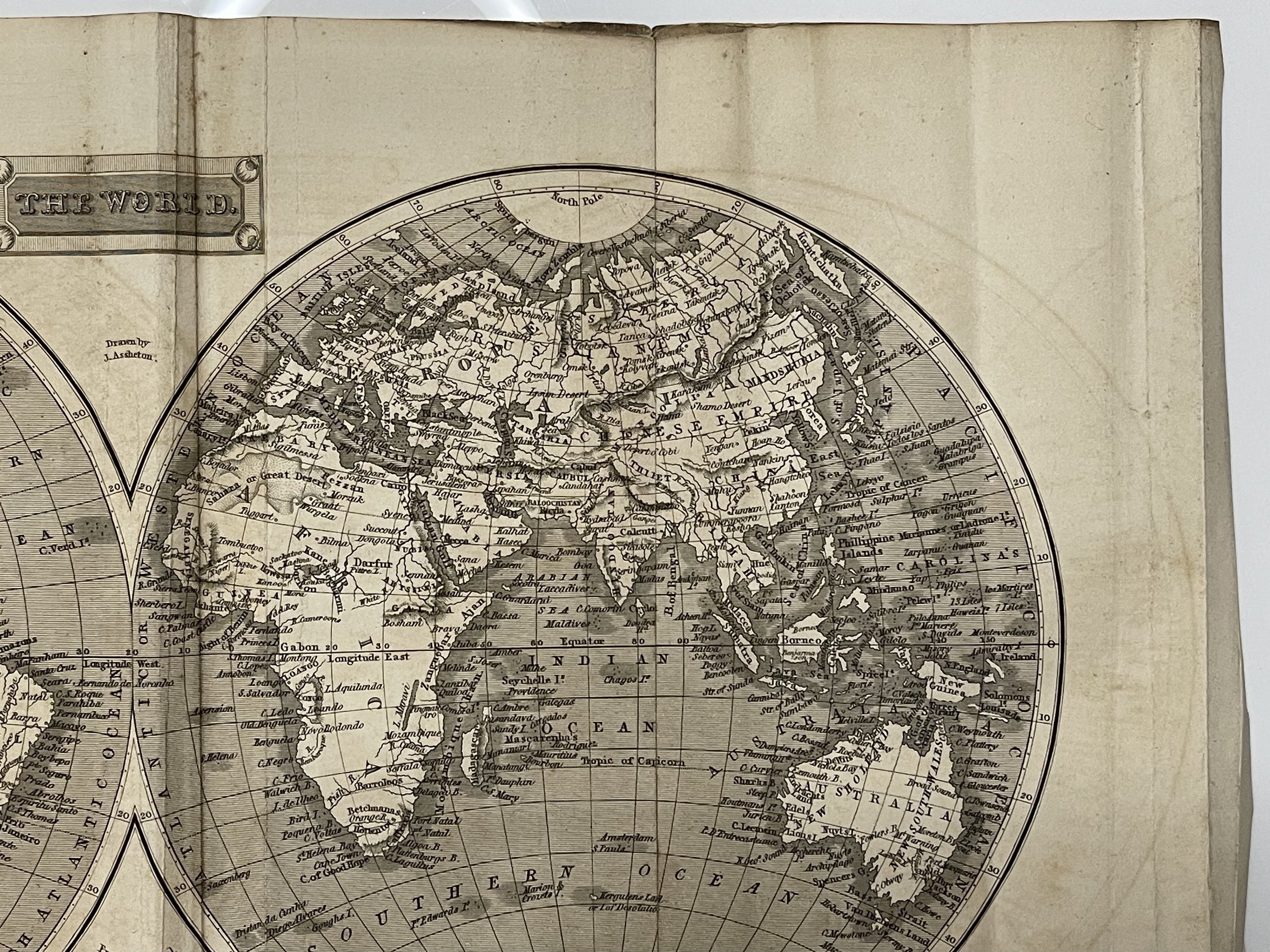 Image 14 of 16
Image 14 of 16

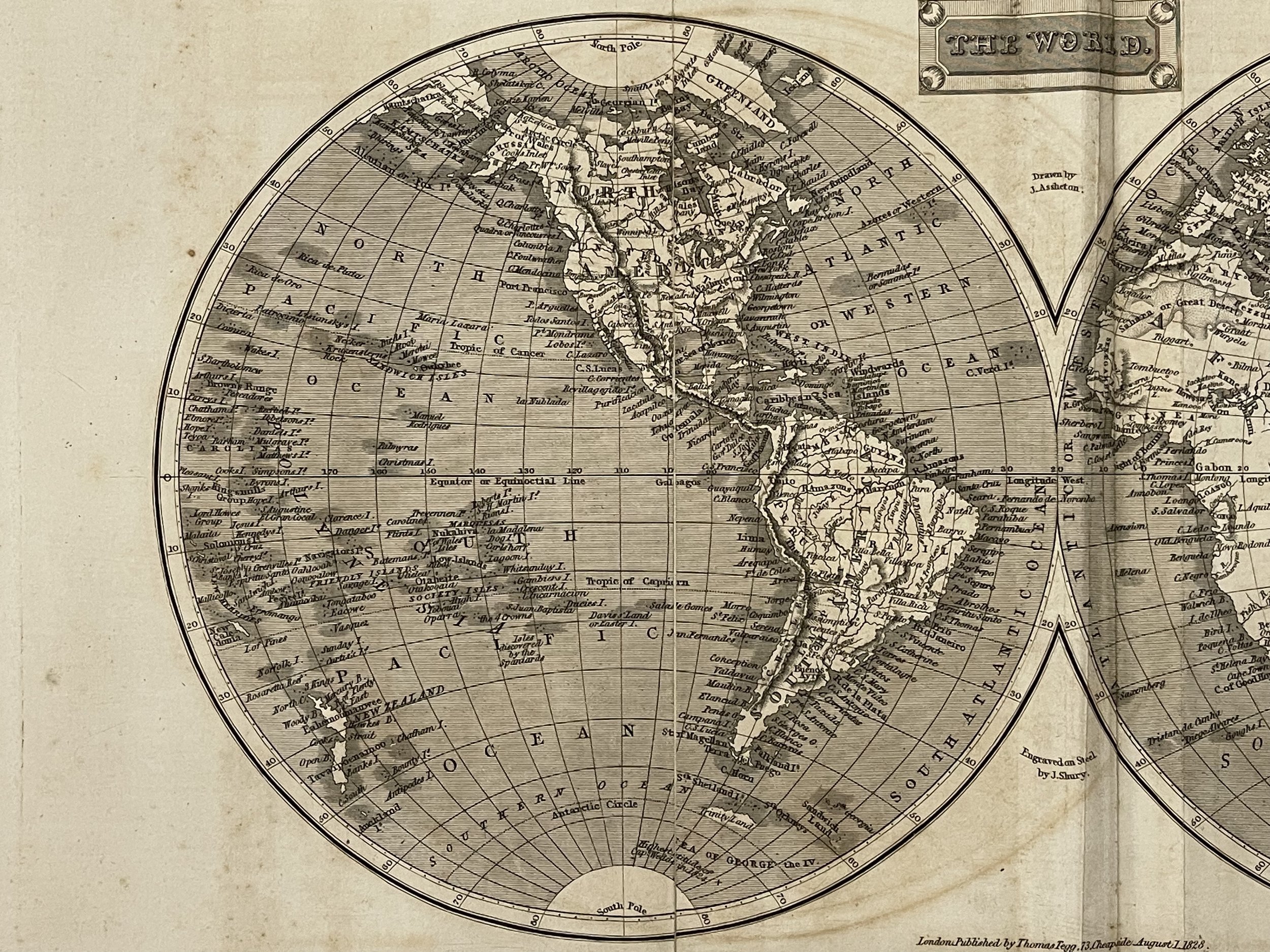 Image 15 of 16
Image 15 of 16

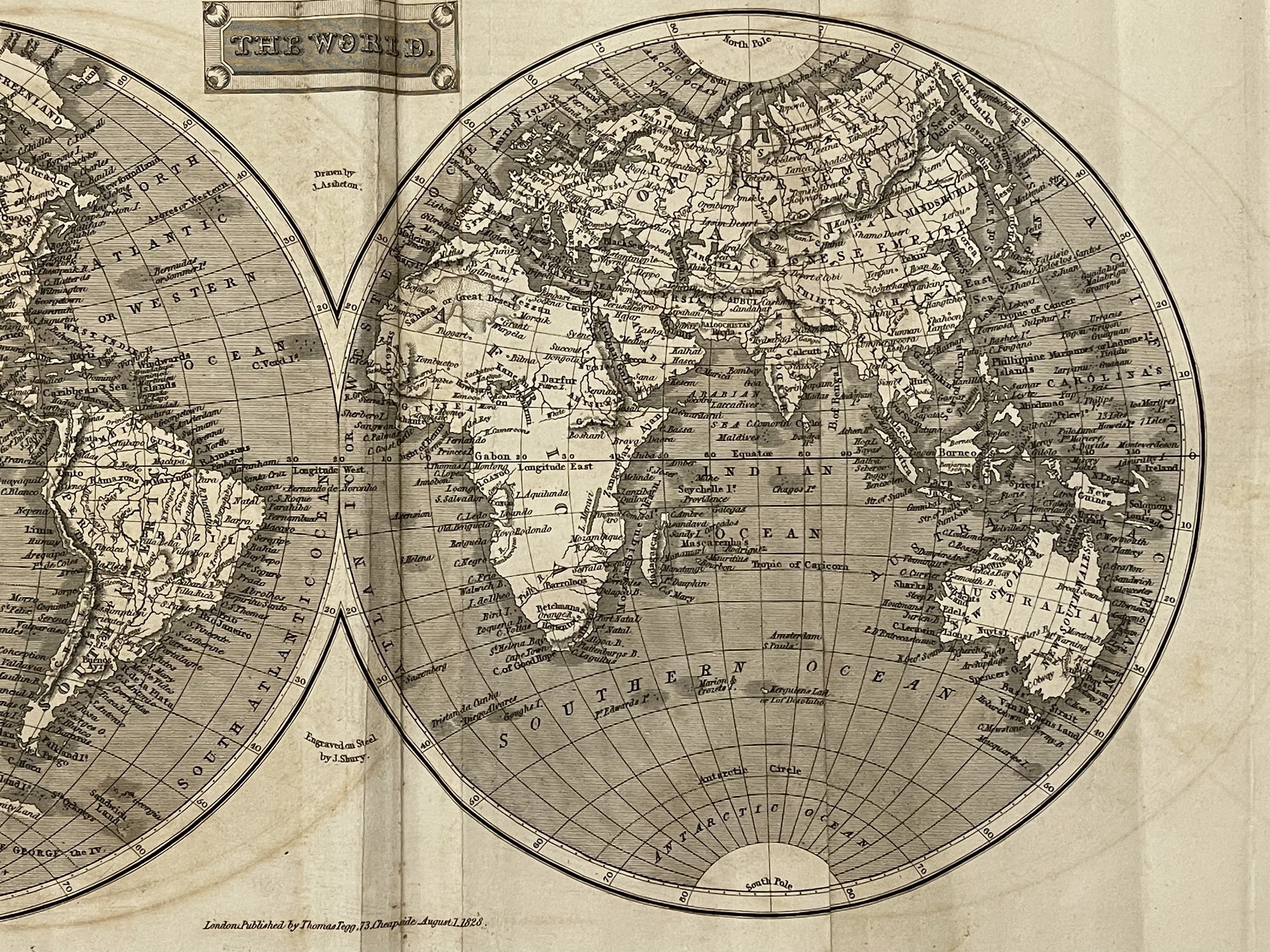 Image 16 of 16
Image 16 of 16

















Map of the World - Thomas Tegg, John Story, J.T Assheton - 1828.
Twin hemispheres map of the world 1828. Most probably from a folio atlas of the time.
Thomas Tegg (1776–1845) was a British bookseller and publisher.
Thomas Tegg was the son of a grocer, born at Wimbledon, Surrey, on 4 March 1776, and was left an orphan at the age of five. He was sent to a boarding school at Galashiels in Selkirkshire. In 1785 he was bound apprentice to Alexander Meggett, a bookseller at Dalkeith. He ran away, sold chapbooks at Berwick, and spent time at Newcastle where he met the wood engraver Thomas Bewick. In Sheffield he obtained employment from Joseph Gales, the proprietor of the Sheffield Register, and encountered Tom Paine and Charles Dibdin. Further wanderings took him to Ireland and Wales, and then, after some years at King's Lynn in Norfolk, he moved to London in 1796.
Thomas Tegg rose to prominence in the book industry, gaining recognition for his publication of reprints and remainders. In addition to this, he also published original works and served as an auctioneer in his early years. While his handwritten autobiography has been lost, his son published some sections of it in 1870. Although not available online, the book was accessible to historian Henry Curwen, who included detailed information about Tegg's early life in his book, A History of Booksellers, the Old and the New (1873). This chapter can be found online, making it unnecessary to repeat all the essential information here.
Tegg was born in 1776 and tragically lost both his father at the age of 5 and his mother at 9. He attended a boarding school in Scotland before starting an apprenticeship with a bookseller. Unfortunately, the bookseller was often intoxicated and abusive, prompting Tegg to run away. After holding various jobs in different locations, he arrived in London in 1796 and found employment at the bookshop of John and Arthur Arch, who were Quakers. With a £200 inheritance, Tegg decided to start his own business, initially partnering with J. Dalton Dewick at 6 West Moreland Buildings, Aldersgate Street. However, their partnership did not last long, and Tegg eventually ventured out on his own, opening The Eccentric Book Warehouse with a partner named Castleman on St. John's Street. However, Castleman's affinity for alcohol hindered the partnership, and Tegg soon moved on.
Tegg then travelled around the country as an auctioneer, acquiring and reselling books for a profit. With his earnings, he returned to London and opened a shop on Cheapside, initially at number 111 and then moving to a larger shop at number 73, known as Old Mansion House. Tegg married Mary Holland in 1800 and had several children, with five of his sons following in his footsteps as booksellers. James and Samuel established themselves in Australia, Thomas junior and Henry in Dublin, and William took over the Cheapside shop before moving it to 12 Pancras Lane. Tegg's shrewd move to send his family members abroad ensured a steady market for his specialised reprints and remainders. In 1825, Tegg took advantage of a financial crisis that caused many publishers and booksellers to sell off their remaining stock at bargain prices. He was able to purchase novels by renowned author Walter Scott for a favourable price and later sell them for a profit, proudly claiming, "I was the broom that swept the booksellers' warehouses."
John Shury (fl. 1801?-1848?)
Topographical draughtsman, engraver and print publisher of landscapes and architectural subjects. Perhaps father of engravers George Salisbury Shury (fl. 1838-61) and Jno. Shury.
Draftsman J.T. Assheton – No information obtainable.
The map is in very good condition with a few ink blemishes compatible to its near 200 years of age. Pricing and grading commensurate.
Twin hemispheres map of the world 1828. Most probably from a folio atlas of the time.
Thomas Tegg (1776–1845) was a British bookseller and publisher.
Thomas Tegg was the son of a grocer, born at Wimbledon, Surrey, on 4 March 1776, and was left an orphan at the age of five. He was sent to a boarding school at Galashiels in Selkirkshire. In 1785 he was bound apprentice to Alexander Meggett, a bookseller at Dalkeith. He ran away, sold chapbooks at Berwick, and spent time at Newcastle where he met the wood engraver Thomas Bewick. In Sheffield he obtained employment from Joseph Gales, the proprietor of the Sheffield Register, and encountered Tom Paine and Charles Dibdin. Further wanderings took him to Ireland and Wales, and then, after some years at King's Lynn in Norfolk, he moved to London in 1796.
Thomas Tegg rose to prominence in the book industry, gaining recognition for his publication of reprints and remainders. In addition to this, he also published original works and served as an auctioneer in his early years. While his handwritten autobiography has been lost, his son published some sections of it in 1870. Although not available online, the book was accessible to historian Henry Curwen, who included detailed information about Tegg's early life in his book, A History of Booksellers, the Old and the New (1873). This chapter can be found online, making it unnecessary to repeat all the essential information here.
Tegg was born in 1776 and tragically lost both his father at the age of 5 and his mother at 9. He attended a boarding school in Scotland before starting an apprenticeship with a bookseller. Unfortunately, the bookseller was often intoxicated and abusive, prompting Tegg to run away. After holding various jobs in different locations, he arrived in London in 1796 and found employment at the bookshop of John and Arthur Arch, who were Quakers. With a £200 inheritance, Tegg decided to start his own business, initially partnering with J. Dalton Dewick at 6 West Moreland Buildings, Aldersgate Street. However, their partnership did not last long, and Tegg eventually ventured out on his own, opening The Eccentric Book Warehouse with a partner named Castleman on St. John's Street. However, Castleman's affinity for alcohol hindered the partnership, and Tegg soon moved on.
Tegg then travelled around the country as an auctioneer, acquiring and reselling books for a profit. With his earnings, he returned to London and opened a shop on Cheapside, initially at number 111 and then moving to a larger shop at number 73, known as Old Mansion House. Tegg married Mary Holland in 1800 and had several children, with five of his sons following in his footsteps as booksellers. James and Samuel established themselves in Australia, Thomas junior and Henry in Dublin, and William took over the Cheapside shop before moving it to 12 Pancras Lane. Tegg's shrewd move to send his family members abroad ensured a steady market for his specialised reprints and remainders. In 1825, Tegg took advantage of a financial crisis that caused many publishers and booksellers to sell off their remaining stock at bargain prices. He was able to purchase novels by renowned author Walter Scott for a favourable price and later sell them for a profit, proudly claiming, "I was the broom that swept the booksellers' warehouses."
John Shury (fl. 1801?-1848?)
Topographical draughtsman, engraver and print publisher of landscapes and architectural subjects. Perhaps father of engravers George Salisbury Shury (fl. 1838-61) and Jno. Shury.
Draftsman J.T. Assheton – No information obtainable.
The map is in very good condition with a few ink blemishes compatible to its near 200 years of age. Pricing and grading commensurate.
Code : A1062
Cartographer : Cartographer / Engraver / Publisher: Thomas Tegg, John Story , J.T Assheton
Date : Publication Place / Date - 1828
Size : Sheet size: 43 x 24 Cm
Availability : Available
Type - Genuine - Antique
Grading A-
Where Applicable - Folds as issued. Light box photo shows the folio leaf centre margin hinge ‘glue’, this is not visible otherwise.
Tracked postage, in casement. Please contact me for postal quotation outside of the UK.